|
|

This chapter provides an overview of the communication server platforms. You will find the following information in this chapter:
Access servers and communication servers connect terminals, modems, microcomputers, and networks over serial lines to local-area networks (LANs) or wide-area networks (WANs). They provide network access to terminals, printers, workstations, and other networks. Remote configuration is also available through Telnet and Digital Equipment Corporation's Maintenance Operation Protocol (MOP) connections to virtual ports on communication and access servers.
Throughout the remainder of this publication, access servers are referred to as communication servers. When there is a need to highlight specific access server features or capabilities, the term access server is used.
Your communication server supports four types of server operation:
Figure 1-1 illustrates these four types of server functionality available on the communication server: terminal service is shown between the terminals and hosts running the same protocol (LAT-to-LAT or TCP-to-TCP); telecommuting service is demonstrated by the remote PC connection running SLIP, CSLIP, PPP, or XRemote; protocol translation service supported between the terminals and hosts running unlike protocols (LAT-to-TCP or TCP-to-LAT); asynchronous IP routing is shown by the PC running SLIP or PPP, and between the two communication servers.
. 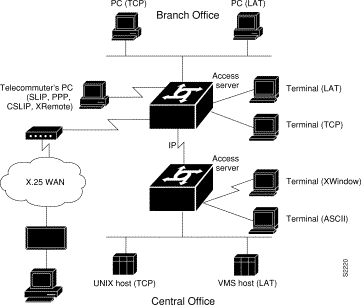
On LANs, terminal services support TCP/IP on UNIX machines with Telnet and rlogin connections, IBM machines with TN3270 connections, and Digital machines with LAT connections. You can use the communication server's protocol translation services to make connections between hosts and resources running different protocols including communication server connections to X.25 machines using X.25 PAD.
Telecommuting services support WAN connectivity with ARA, SLIP, PPP, or XRemote. Other WAN services include dial-on-demand routing (DDR) of IP and IPX, X.25, Frame Relay, and SMDS. Full IP and Novell IPX routing services are also supported. Communication and access servers are network-compatible with routers, which you can use to extend your network to any size you need.
Full network access control features help to ensure system security and efficiency. Security features provide restrictions to resources on the network. The network manager can specify access lists to permit and deny users access to internetworked computers. A username and password-pair authentication scheme is also supported.
Communication servers provide terminal-to-host connectivity using virtual terminal protocols including Telnet, LAT, TN3270, rlogin, and X.25 PAD (X.25 PAD connections can be made with the ASM-CS only). Modems can be configured for rotary connections, allowing users to connect to the next available modem.
A host can also connect directly to a communication server. In IBM environments, TN3270 allows a standard ASCII terminal to emulate a 3278 terminal and access an IBM host across an IP network.
In Digital environments, LAT support provides a terminal with connections to VMS hosts. X.25 PAD allows terminals to connect directly to an X.25 host over an X.25 network through the communication server. X.25 PAD eliminates the need for a separate PAD device. This connection requires a synchronous serial interface.
Figure 1-2 illustrates terminal-to-host connections using a communication server.
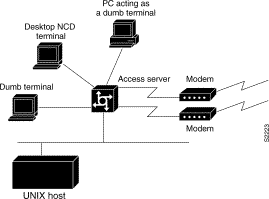
Using ARA, SLIP, or PPP, PC users can run TCP/IP applications and services including Telnet, Simple Mail Transfer Protocol (SMTP), and File Transfer Protocol (FTP) over serial lines. The user gets remote connectivity with the same functionality as a PC attached to a local network. Another telecommuting option is to use the XRemote protocol over asynchronous lines. The communication server provides network functionality to remote X display terminals.
Figure 1-3 illustrates an XRemote connection using a communication server. See the chapter "Configuring XRemote" in the Access and Communication Servers Configuration Guide for additional possible XRemote configurations.
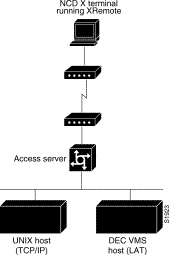
Figure 1-4 shows a generic telecommuting connection.
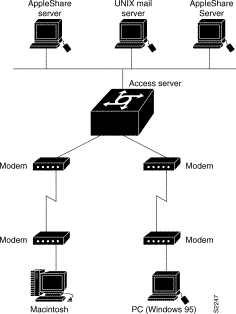
Communication servers translate virtual terminal protocols to allow communication between devices running different protocols. Protocol translation supports Telnet (TCP), LAT, and X.25. One-step protocol translation software performs bidirectional translation between any of the following protocols:
Figure 1-5 illustrates LAT-to-TCP protocol translation.
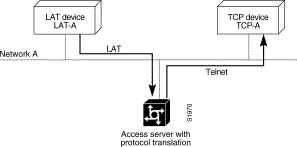
Connecting to IBM hosts from LAT, Telnet, rlogin, and X.25 PAD environments is accomplished with two-step translations. In other words, users must first establish a connection with the communication server, then use the TN3270 facility to make a connection to the IBM host.
Communication servers support full routing functionality, determining the most efficient path for sending data packets to a destination address outside the local network. The communication server gathers and maintains routing information to enable the transmission and receipt of such data packets. Routing information takes the form of entries in a routing table, with one entry for each identified route. The communication server can create and maintain the routing table dynamically to accommodate network-configuration changes when they occur.
Communication servers allow you to route IP and IPX packets over synchronous and asynchronous lines. DDR of IP and IPX packets is supported. A key feature of asynchronous routing is its ability to provide low-cost operation over normal dial-up telephone networks. The communication server's routing capabilities provide remote home and sales offices with cost-effective access to a central site. For example, traffic from PCs and UNIX workstations can be routed through the communication server, eliminating multiple phone lines and modems. Routing over asynchronous lines also provides significant phone-line savings for small offices by allowing dial-up telephone lines to be used rather than more costly leased lines.
All of the IP and IPX routing protocols and special features that are implemented on our routers are available on your communication server. Routing protocols include Internet Gateway Routing Protocol (IGRP), Enhanced Internet Gateway Routing Protocol (Enhanced IGRP), Open Shortest Path First (OSPF), Routing Information Protocol (RIP), Border Gateway Protocol (BGP), Exterior Gateway Protocol (EGP), Gateway Discovery protocol (GDP), and ICMP Router Discovery Protocol (IRDP). Special routing features include route filtering, priority queuing, access lists, and more.
Figure 1-6 illustrates an IP routing configuration using communication servers. In this configuration, the host is connected to an Ethernet and forms a routing connection with communication servers at remote sites.
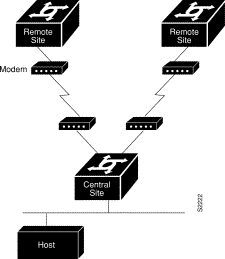
A user can dial in and use a port for any of the following types of connections:
This range of functionality is possible because multiple roles can be assigned to each asynchronous interface. Each asynchronous line can be used as a network interface for IP routing some of the time, as a source of data for terminal-server communications (using Telnet, LAT, rlogin, and so forth), for protocol translation, and for telecommuting (using XRemote and SLIP).
Communication servers handle multiple device interfaces. Asynchronous RS-232 serial lines are aggregated onto a high-speed network interface. ASCII terminals, modems, printers, and host serial ports are among the devices you can connect to communication servers. Our communication server platforms provide a number of methods to connect serial devices, including RJ-11, RJ-45, and 50-pin Telco connectors. The 500-CS supports RJ-45 connectors only. The ASM-CS supports Telco and RJ-11 connectors. The Cisco 2500 Series supports RJ-45 connectors on "octopus" cable adapters that attach to high-density D-type connectors on the rear panel of the Cisco 2500.
The network interfaces for communication servers provide easy connectivity. The network interface is typically Ethernet, but can also be synchronous serial lines and Token Rings (ASM-CS only).
Using communication servers, any RS-232-compatible device, serial laser printer, film recorder, plotter, and so on, can become a shared resource to your organization over a local network.
Part of the power and flexibility of your communication server results from the range of possible physical configuration options. You can choose from single-board systems, or card-based chassis configurations that offer processor, back-panel connector mountings, and communications interfaces best suited to their network.
The following communication server models are available:
All our communication servers contain onboard RAM, system ROM holding all operating system software, bootstrap software, and diagnostic software.
Our systems also include nonvolatile memory that retains configuration information despite power losses or system reboots. With the nonvolatile memory option, the terminal and network servers need not rely on other network servers for configuration and boot service information.
|
|